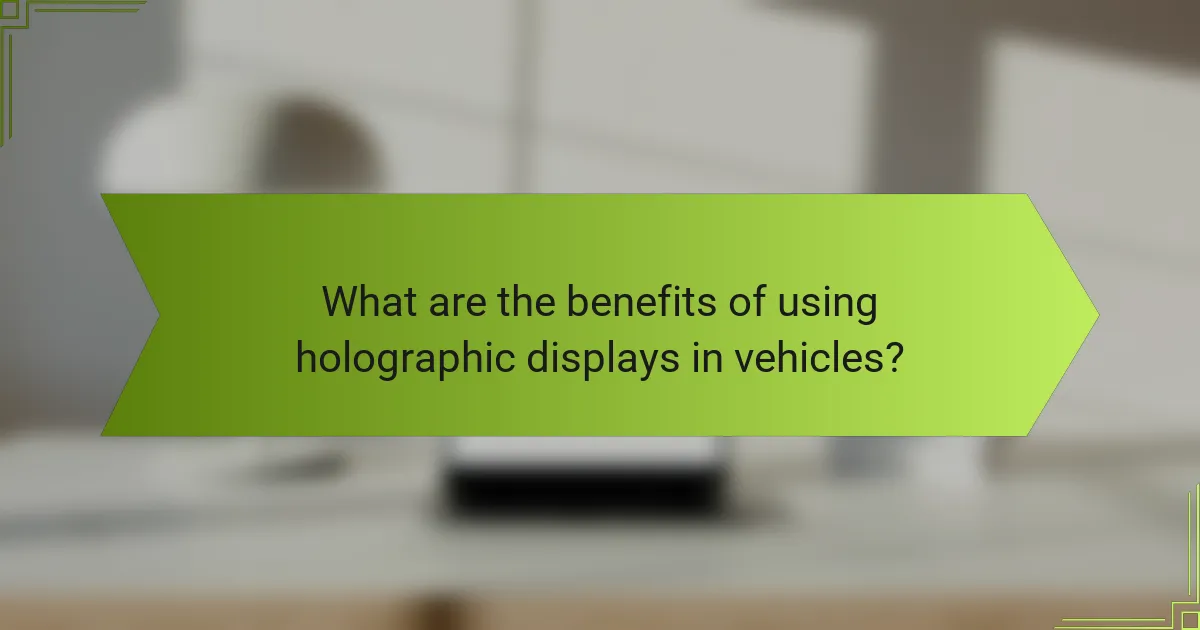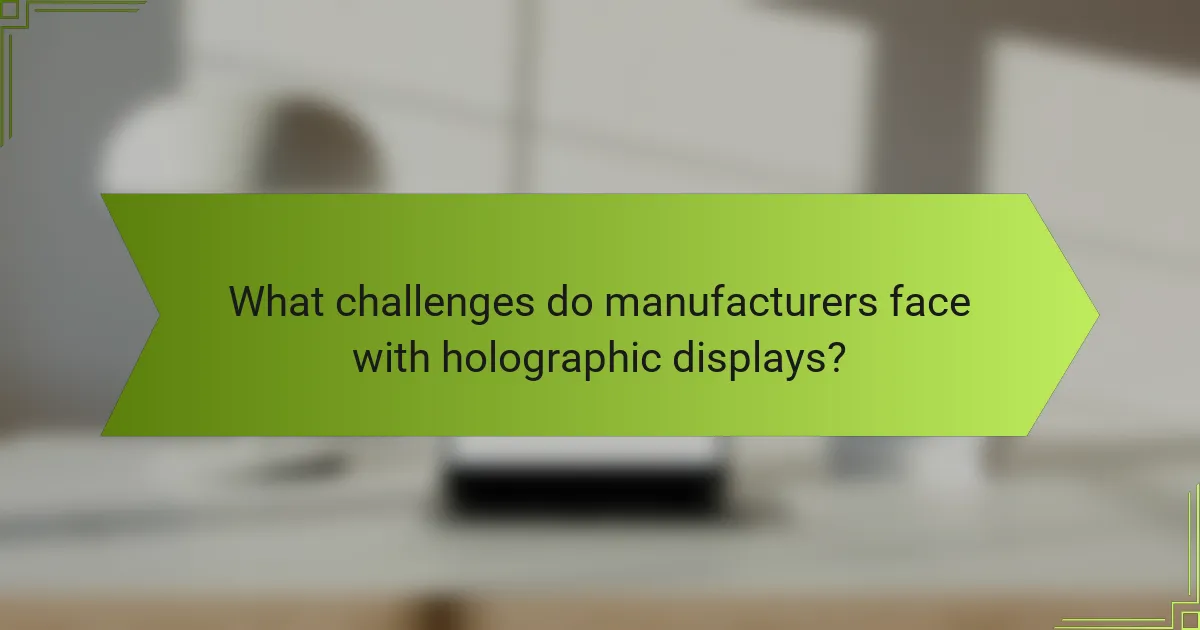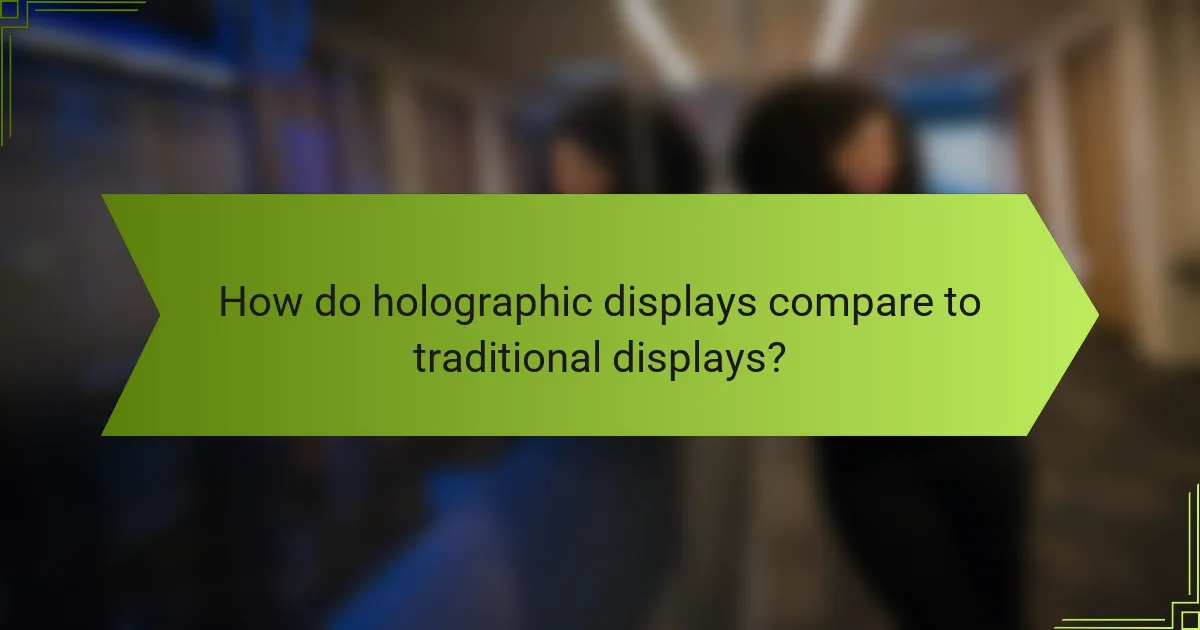Holographic displays are transforming automotive design by enhancing visual communication and interactivity within vehicles. Leading brands such as Mercedes-Benz, Tesla, and Audi are pioneering this technology, creating immersive experiences that improve user engagement and functionality while seamlessly integrating into modern car interiors.

How are holographic displays transforming automotive design?
Holographic displays are revolutionizing automotive design by enhancing visual communication and interactivity within vehicles. These advanced displays provide immersive experiences that improve user engagement and functionality while integrating seamlessly into modern car interiors.
Enhanced user experience
Holographic displays significantly elevate the user experience by providing intuitive interfaces that are easy to navigate. Drivers can access navigation, entertainment, and vehicle information through 3D visuals that reduce distraction and improve usability.
For instance, a holographic navigation system can project route directions directly onto the windshield, allowing drivers to keep their eyes on the road. This immersive interaction creates a more engaging environment, making driving more enjoyable and less stressful.
Improved safety features
Safety is a primary concern in automotive design, and holographic displays contribute by providing critical information in a non-intrusive manner. By projecting alerts and warnings directly into the driver’s line of sight, these displays help maintain focus on the road.
Examples include real-time hazard alerts and speed limit notifications that appear as holograms, allowing drivers to react quickly without taking their eyes off the road. This technology can also integrate with advanced driver-assistance systems (ADAS) to enhance overall vehicle safety.
Real-time data visualization
Holographic displays facilitate real-time data visualization, allowing drivers to monitor vehicle performance and environmental conditions effortlessly. This capability provides essential metrics, such as fuel efficiency and battery status, in a visually engaging format.
For example, a driver can view engine diagnostics or tire pressure information projected in 3D, making it easier to understand and act upon. This immediate access to information empowers drivers to make informed decisions, ultimately enhancing vehicle maintenance and safety.

Which brands are leading in holographic display technology?
Several automotive brands are at the forefront of holographic display technology, enhancing user experience and safety. Notable leaders include Mercedes-Benz, Tesla, and Audi, each integrating advanced holographic systems into their vehicles to improve navigation and information accessibility.
Mercedes-Benz
Mercedes-Benz is pioneering the use of holographic displays in its high-end models, particularly with the MBUX Hyperscreen. This expansive display integrates multiple functionalities, allowing drivers to access navigation, entertainment, and vehicle information seamlessly. The holographic interface enhances user interaction by providing a three-dimensional perspective, making it easier to focus on essential data while driving.
Key considerations for Mercedes-Benz’s holographic technology include its intuitive design and responsiveness. Users appreciate the low latency and high clarity, which contribute to a safer driving experience. However, the complexity of the system may require a learning curve for some users.
Tesla
Tesla incorporates holographic display technology primarily through its advanced infotainment systems. The brand focuses on delivering real-time data and navigation in a visually engaging manner. Tesla’s approach emphasizes user customization, allowing drivers to tailor the display to their preferences, enhancing both functionality and aesthetics.
When using Tesla’s holographic displays, drivers benefit from quick access to critical information, such as battery status and autopilot features. However, potential pitfalls include over-reliance on visual data, which may distract from road conditions. Tesla encourages users to maintain focus on driving while utilizing these advanced features.
Audi
Audi is integrating holographic displays into its vehicles to enhance the driving experience, particularly with its Virtual Cockpit technology. This system provides a customizable digital dashboard that presents vital information in a holographic format, improving visibility and engagement. Audi’s focus on driver-centric design ensures that essential data is easily accessible without overwhelming the user.
For Audi owners, the holographic display offers a blend of style and functionality. Users can expect high-resolution graphics and responsive controls, which contribute to a modern driving experience. However, drivers should be mindful of the potential for information overload, ensuring that they prioritize essential data while on the road.

What are the key case studies in automotive holographic displays?
Key case studies in automotive holographic displays showcase innovative applications that enhance user experience and vehicle functionality. Leading brands like Mercedes-Benz, Tesla, and Audi have integrated holographic technology into their systems, providing drivers with intuitive interfaces and improved information accessibility.
Mercedes-Benz MBUX system
The Mercedes-Benz User Experience (MBUX) system utilizes holographic displays to create an interactive and immersive driving environment. This system features a high-resolution screen that projects essential information, such as navigation and vehicle status, directly in the driver’s line of sight.
One notable aspect of MBUX is its voice recognition capabilities, allowing drivers to control various functions hands-free. This enhances safety by minimizing distractions, making it easier to access features while keeping attention on the road.
Tesla’s augmented reality interface
Tesla has pioneered the use of augmented reality (AR) in its vehicle displays, providing a holographic-like experience that overlays information onto the real world. This interface helps drivers by displaying navigation prompts and vehicle diagnostics in a visually engaging manner.
The AR interface also adapts to real-time conditions, such as traffic and road hazards, ensuring that drivers receive timely and relevant information. This feature not only improves situational awareness but also enhances the overall driving experience.
Audi’s virtual cockpit
Audi’s virtual cockpit integrates holographic technology to deliver a customizable digital dashboard. This system allows drivers to choose what information they want to display, from speed and navigation to media controls, all in a clear and visually appealing format.
By utilizing a fully digital interface, Audi enhances the aesthetic appeal of the dashboard while providing practical functionality. The virtual cockpit can also be updated over-the-air, ensuring that drivers always have access to the latest features and improvements without needing to visit a dealership.

What are the benefits of using holographic displays in vehicles?
Holographic displays in vehicles enhance user experience by providing immersive visuals and interactive interfaces. These displays can improve safety and functionality, making them a valuable addition to modern automotive design.
Increased engagement
Holographic displays captivate drivers and passengers by presenting information in a visually striking manner. This engagement can lead to a more enjoyable driving experience, as users interact with 3D representations of navigation, vehicle status, and entertainment options.
For instance, a holographic navigation system can project route information in the driver’s line of sight, making it easier to follow directions without taking eyes off the road. This immersive experience can foster a deeper connection between the user and the vehicle.
Reduced driver distraction
By integrating holographic displays, critical information is presented in a way that minimizes the need for drivers to look away from the road. This technology allows for heads-up displays that keep essential data, such as speed and navigation, within the driver’s peripheral vision.
Studies suggest that reducing the time spent looking away from the road can significantly lower the risk of accidents. Holographic displays can also use voice commands to further decrease manual interaction, allowing drivers to maintain focus on driving.
Customizable interfaces
Holographic displays offer the advantage of customizable interfaces tailored to individual user preferences. Drivers can adjust the layout, color schemes, and types of information displayed, enhancing usability and comfort.
This personalization can be particularly beneficial in multi-user vehicles, where different drivers may have distinct preferences. For example, a driver might choose to display performance metrics prominently, while another may prioritize entertainment options, creating a more user-friendly environment.

What challenges do manufacturers face with holographic displays?
Manufacturers encounter several challenges with holographic displays, including high production costs, technological limitations, and regulatory hurdles. These factors can significantly impact the feasibility and scalability of integrating holographic technology into automotive design.
High production costs
The production costs of holographic displays are notably high due to the advanced materials and technology required. Manufacturers must invest in specialized equipment and skilled labor, which can lead to overall expenses that are substantially higher than traditional display technologies.
For example, the cost of developing a prototype holographic display can range from tens of thousands to hundreds of thousands of dollars. This financial barrier can deter smaller manufacturers from entering the market or limit the scale at which larger companies can implement this technology.
Technological limitations
Technological limitations pose significant challenges for holographic displays in automotive design. Current holographic technology may struggle with issues such as resolution, brightness, and viewing angles, which can affect user experience and safety.
Moreover, the integration of holographic displays with existing vehicle systems requires advanced software and hardware compatibility. This complexity can lead to longer development times and increased risk of technical failures during implementation.
Regulatory hurdles
Regulatory hurdles can complicate the adoption of holographic displays in the automotive sector. Manufacturers must navigate various safety and compliance standards, which can differ significantly across regions and countries.
For instance, in the European Union, automotive displays must comply with specific regulations regarding visibility and distraction to drivers. Meeting these standards can prolong the development process and increase costs, making it essential for manufacturers to stay informed about local regulations and adapt their designs accordingly.

How do holographic displays compare to traditional displays?
Holographic displays offer distinct advantages over traditional displays, primarily in terms of depth perception and viewing angles. These features enhance user interaction and can significantly improve the driving experience in automotive design.
Depth perception advantages
Holographic displays create a three-dimensional image that appears to float in space, allowing for improved depth perception compared to flat screens. This depth can help drivers better gauge distances and spatial relationships, which is crucial for tasks like parking or navigating tight spaces.
For example, a holographic navigation system can project route information directly onto the road, making it easier for drivers to follow directions without losing focus on the environment. This immersive experience can reduce cognitive load and enhance safety.
Wider viewing angles
Holographic displays provide wider viewing angles than traditional displays, allowing multiple passengers to see the information clearly without distortion. This is particularly beneficial in vehicles where the driver and passengers may be seated at different angles.
With a typical traditional display, colors and contrast can shift significantly when viewed from the side. In contrast, holographic technology maintains image integrity across a broader range of angles, ensuring that all occupants can access the same visual information simultaneously.
